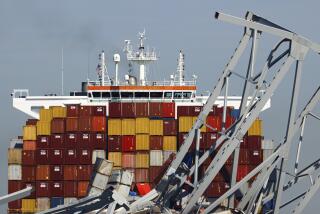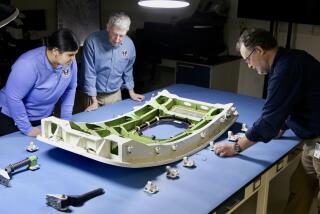Experts Studying Engine Stalls as Cause of DC-9 Crash
DENVER — The engines of the jetliner that crashed here Sunday apparently suffered problems that could have resulted in significant loss of power in the seconds before the plane slammed into the ground, federal officials said here Thursday night.
Jim Burnett, chairman of the National Transportation Safety Board, which is investigating the crash, said experts listening to a transcript from the “black box” cockpit voice recorder recovered in the wreckage of the Continental Airlines DC-9 believe they heard the sounds of engine compression stalls, or “engine surging.”
While Burnett described such stalls as a sort of “burp,” Wally Roberts, a veteran airline pilot who has flown the DC-9, used stronger terms.
‘Momentary Loss in Power’
“A compression stall causes a momentary loss or drop in power,” he said. “There can be a significant loss in power for several seconds.”
The runways at Denver’s Stapleton International Airport were wet and slushy when the plane made its unsuccessful attempt to take off during a snowstorm, and Roberts noted that the DC-9’s manufacturer had warned that the aircraft is especially vulnerable to compression stalls when attempting to take off under such conditions.
“There’s a real problem with wet runways with a DC-9. Because of the way it’s designed, the engines can ingest water thrown up by the nose wheel,” Roberts said.
The manufacturer also noted that ice or slush on the wings can break off during takeoff and tumble back into the plane’s two engines, which are mounted near the tail.
Triggered by Disturbed Air
Burnett explained Thursday night that compression stalls result when the normal airflow into the engine is somehow disturbed.
Like Roberts, he said the ingestion of “foreign objects,” such as ice, slush or water, could do this.
But Burnett also said that compression stalls can sometimes occur when some other problem forces a plane into an unusual pitch, thus disturbing the flow of air into the engines.
Burnett pointed out that it is not yet known, for sure, if compression stalls did occur in Sunday’s accident. And if they did occur, he said, it might have been after the plane was already in trouble, headed for the ground.
In all, 28 of the 82 aboard Flight 1713 were killed when the plane faltered and then slammed back to earth while attempting to lift off on a scheduled flight to Boise, Ida.
Focus Put on Three Factors
Although Burnett continues to caution that it’s far too early to speculate on what caused the crash, attention is now focused on three possible factors:
--Possible compression stalls.
--The possibility that ice accumulating on the wings while the plane waited in sub-freezing temperatures for takeoff could have added extra weight to the aircraft and altered the shape of the wings so that they didn’t provide enough lift as usual.
--The relative inexperience of the pilot and co-pilot.
In addition, Continental officials talked Thursday about the possibility that the DC-9 might have been flung about by turbulence generated by a jumbo jetliner that had landed moments earlier on a nearby runway.
Should such turbulence be found to be a causal factor, attention might be drawn more to the air traffic controllers responsible for maintaining separation between aircraft and less to the airline and its cockpit crew.
On Wednesday night, Burnett told a regularly scheduled press briefing that a Delta Airlines Boeing 767 jumbo jetliner had landed at Stapleton’s Runway 35-Right at about 2:12 MST Sunday afternoon, approximately two minutes before the Continental DC-9 crashed while attempting to take off from Runway 35-Left.
The two runways are parallel, separated by a rolling, grassy median strip about 1,900 feet wide.
Continental noted Thursday morning that jumbo jets like the Boeing 767 often trail two spiraling vortices of wind behind them--one from each wing tip.
Whirlwinds Often Persist
Capt. Richard Hillman, a Continental pilot assisting in the airline’s investigation, said these horizontal whirlwinds--called “wake turbulence”--often persist for several minutes after a jumbo jet passes by. He said such vortices can often drift, pushed by prevailing winds.
Witnesses have said the DC-9 pitched to the left and right and then overturned seconds after lifting off from Runway 35-Left.
Although neither Continental nor the NTSB has offered any evidence that the DC-9 was struck by wake turbulence, Hillman suggested Thursday that the prevailing winds at the airport might have caused the vortices from the jumbo jet to drift the 1,900 feet across from Runway 35-Right to Runway 35-Left.
Burnett said Thursday afternoon that neither that, nor any other possibility, has yet been discounted in the investigation.
However, while several other pilots have said that the snowy conditions, sub-freezing temperatures and a long wait after de-icing might have created a “classic” icing situation in the moments before the crash, Hillman tended to discount icing when he talked to reporters on Thursday.
‘Not Classic Icing Situation’
“In my personal opinion, I have pushed aside the icing situation,” the Continental captain said at a news conference called by the airline. “In my opinion, it was not a classic icing situation.”
Such comments are unusual during the early stages of an NTSB investigation, especially from someone like Hillman who is a party to the probe.
Hillman said he based his opinion on early transcripts from the cockpit voice recorder recovered from the wreckage, which gave no indication that either the captain of the plane, Frank Zvonek, 43, of Carlsbad, Calif., or the co-pilot, Lee Bruecher, 26, of Houston, mentioned icing in the minutes before the takeoff attempt.
While Continental has defended the two pilots as “fully qualified” by the Federal Aviation Administration to handle the DC-9, others have noted that both men were relatively new to the plane.
Cockpit Pairings Questioned
Burnett--and others--have said that captains and first officers with relatively little individual time in a particular aircraft should not be paired in the cockpit of that aircraft.
The wreckage of the DC-9 was moved earlier this week from the crash site beside Runway 35-Left to a hangar leased by Continental at Stapleton Airport.
Burnett said Thursday the debris will remain there until the investigation is finished.
After that, Continental, which has already painted out all of its trademarks and logos on the wreckage so they will no longer appear in photos, can dispose of the debris as it sees fit.
More to Read
Sign up for Essential California
The most important California stories and recommendations in your inbox every morning.
You may occasionally receive promotional content from the Los Angeles Times.










